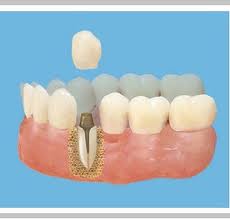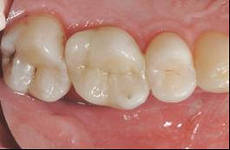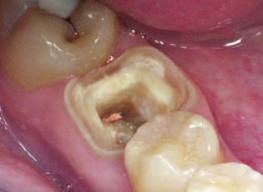Tooth tabs

Tabs for teeth - individual fragments of teeth that replace only their destroyed part.
Dental inlays are necessary when a regular filling will not help anymore, and the teeth can still be preserved. With the help of a tooth insert, it is possible to correct a defect in a damaged tooth by giving it its former shape, and also protect the tooth from further destruction.
With significant damage to the teeth, a titanium insert can strengthen the tab. The tab in the tooth will help with the installation of the crown and will become a reliable support for the bridge.
Tab prosthetics
Tabbed prosthetics is one of the fast, effective and cheapest ways to restore them.
The tooth tab is fixed to the tooth using special cement. Then the tab is polished in order to give it aesthetics.
Dental tabs under the crown are used in cases where the tooth crown is badly damaged and the root is in good condition. The tab in the tooth under the crown (stump tab) allows you to restore the functionality of the tooth and prepare it for prosthetics. The tooth under the tab, before installing it should be prepared.

The pin insert consists of the top of the tooth and the pin (See photo).
Such tabs are practically not used as an independent prosthetics, but are the basis for fixing the dental crown or are used as a support for a bridge.
In rare cases, the upper part of the stump tab may be covered with a facing material to give the design aesthetics.
Advantages of prosthetics with tabs:
- The tooth restoration tab allows you to save its appearance and function.
- The tooth tab is stronger and more durable fillings.
- Tabs for teeth are not subject to polymerization and shrinkage.
- Resistance of tabs to various coloring substances.
- With the help of a dental insert, it is possible to close cavities in the teeth, even of large sizes.
- Dental tabs allow the preparation of the tooth for the installation of crowns and bridges.
- The ability to prevent the abrasion of enamel on the teeth.
- Full compatibility with different types of dentures, thereby increasing the effectiveness of prosthetics.
Types of Dental Tabs
Types of tooth tabs:
- Recovery tabs. With their help, the tooth restores its shape and color.
- Stump tabs. With their use, restoration of the crown of the tooth is possible.
Dental inlays are made from the best filling materials, which are highly durable and have a wide range of colors. Tabs for teeth can be made of composite synthetic materials, ceramics, from materials based on glass (glass) and from metal alloys.
Some of the materials are the most popular; metals and their alloys, on the contrary, are rarely used. Materials such as porcelain, ceramics, composite materials, ceramic materials are closer to natural teeth in their aesthetic and physical indicators.
Types of Recovery Tabs

- Tabs made of metal. They are usually made of gold or alloys. They are not very aesthetic, so they are usually placed on chewing teeth. This type of tabs is more reliable than composite fillings.
- Ceramic tabs. In aesthetics, they are identical to porcelain tabs. Therefore, they are often used on the front teeth.
- Ceramic-metal tabs. The cost of such tabs is equal to ceramics, but their quality is much worse. They often fall out.
- Composite tab. Their cost is higher than the cost of the seal, and in quality do not differ from the seal. Over time, the composite tabs fade and darken.
Ceramic tooth tabs
Ceramic tooth inlays today are in great demand due to the high aesthetics, strength, reliability and durability. They have no flaws.
Ceramic dental inlays (see photo) are often made of ceramic.
A ceramic insert in the tooth is necessary in case of severe destruction, when there is a very large cavity inside the tooth, in which it is impossible to fix the filling.
Indications and contraindications
Indications for use of tooth tabs:
- Large defects in the crowns of teeth that cannot be filled.
- Tooth decay is more than 30%.
- Increased abrasion of tooth enamel.
- To improve the support of the elements of bridges.
Contraindications to the use of tabs for teeth:
- Shallow depth of cavity.
- High caries activity.
- The proximal cavity deep into the dentin.
- The presence of steep slopes of the hillocks.
- Teeth grinding (bruxism).
- Poor oral hygiene.
With the destruction of the posterior teeth, the tab in the wisdom tooth is impractical because it does not have chewing function. In case of destruction of the wisdom tooth, it will be more correct to remove it.
Pros and cons of tooth tabs

Pros of dental tabs:
- Ceramics almost completely correspond to tooth enamel in its structure and color. This gives the ceramic teeth a natural look.
- Reliability and quality of metal and ceramic inlays.
- Modern technologies for the manufacture of tabs allow you to make them so that the size of the tooth defect and tabs are completely the same. While the seals have the worst rates.
- In the manufacture of tabs take into account all the individual characteristics of the bite.
- The strength of the tabs is higher than the seals.
Cons of tabs for teeth:
- The cost of dental inlays, compared with fillings, due to the complexity of manufacturing, high cost and quality, is much higher.
- Duration of dental treatment is longer than when installing fillings.
Life time
The service life of the dental inlays depends on the material used.
Inlays for teeth made of gold can last more than 15 years, and from other metal - more than 10 years.
The service life of porcelain inlays is shorter and ranges from 5 to 7 years.
With careful handling and thorough oral hygiene, the life of the insert and tooth can be extended.
Complications

The preparation of teeth under the tabs is a process of excision of the hard tissues of the dental crown, in order to give the internal cavity the necessary shape. Since the procedure of dental preparation is similar to surgery, the preparation of the tooth under the tab can cause complications such as:
- secondary caries;
- the development of acute and chronic pulpitis.
If tooth aches after setting tab, then the cause most often may be increased tooth sensitivity. If the tab has dropped out of the tooth, then this may occur as a result of opening the cavity.
Tab Care
Care for the dental tabs should be the same as for the teeth. It involves hygienic brushing, and rinsing the mouth with water after eating.
Tab loads should be avoided.
If you follow the above rules, then the tooth tabs will last a sufficient number of years.
Cost
How much does it cost to put a tooth tab?
Ceramic tab - from 12,000 to 17,000 rubles
Alloy metal tab - from 3500 rubles
The cost of a dental inlay made of gold depends on the size of the inlay and the mass of gold.
